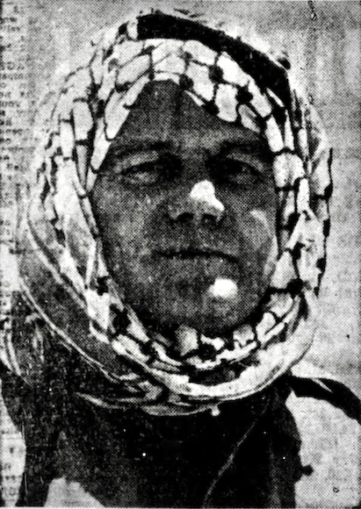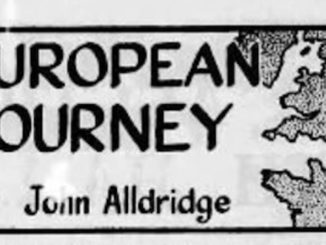In 1961 my uncle, John Alldridge spent some time on the set of Lawrence of Arabia and reported his experiences for the Birmingham Mail – Jerry F

Newspaper article header, Birmingham Mail,
Unknown photographer – © 2022 Newspapers.com, reproduced with permission
Jebel Tubeiq, Jordan
According to the Bedouin, that supercilious look for which the camel is noted is due to the fact that Allah has a hundred names.
Man knows 99 of them. Only the camel knows the hundredth. This makes the camel superior to all other beasts.
The camel is perfectly well aware of this, of course. And in the making of the film, “Lawrence of Arabia” where the camels outnumber the men by 10 to one (in one battle scene 1,500 of them will be used) the wily camel is making the most of it.
Most actors on location demand a “stand-in” for the rough work. The three camel “stars” of “Lawrence of Arabia” (renamed, with bitter irony, Faith, Hope, and Charity) have 13 understudies to call on. This only aggravates their sense of importance.
The other afternoon, with the temperature standing uneasily at 119 degrees, David Lean was rehearsing an early scene in the film in which Lawrence, making his first trip into the desert, meets his Arab guide, Tafas, who has been sent to bring him to Feisal.
This called for Tafas (Zia Mohyeddin, from Pakistan), riding Faith, to move slowly into close-up while Lawrence, (Peter O’Toole) riding Charity, relaxed out of camera. This was altogether too much for Charity’s ego. Like an old professional, she bided her time until Lean switched over to sound for the first take; and then each time Faith ambled into camera, Charity on the sidelines, would ruin the take with that peculiar high-pitched neigh; a one-word expression of camel contempt which, when accompanied by a stream of saliva, sounds like “Tah!” but obviously means “drop dead!”
Of course, the camel has the supreme advantage of being absolutely at home in the desert, whereas few men ever are.
Every actor in this film must learn to ride a camel – and ride it well. For he will be appearing in company with Bedouin, fearless camelmen born to the saddle.
It takes a skilled horseman at least two months to ride a camel properly. Most of the European actors have had to do as well as they can in three or four weeks.
The heaviest responsibility, of course, falls on Peter O’Toole, playing Colonel Lawrence; for Lawrence could ride as well as, if not better than, most Arabs.
Although a big man for camel-back (he tops 6ft, whereas Lawrence was only 5ft 4in., and rarely weighed more than seven stone) in 10 weeks he has become remarkably proficient.
He has a “stable” of three camels to choose from. All female, bred from racing stock in the deserts of the south (where the swiftest camels are sold for fantastic prices to smugglers sneaking contraband across four complicated borders), they go like the wind.
“Some are more comfortable than others,” says O’Toole, from bitter experience. “You simply have to try them for size. The first two models they brought out of the showroom were too small for me and I couldn’t get used to the gear shift.
“The one I’m riding now shifts automatically.”
The first week or two on camel-back is agony to the beginner. The unusual cork-screw saddle-roll brings into play rump muscles rarely used in normal conditions. After two hours upon a camel, sitting down becomes an embarrassment.
O’Toole solved that one by cunningly slipping a large square of foam rubber between the wooden saddle and his buttocks. Now every Arab for miles around rides on foam rubber…
“It is easy to sit on a camel’s back without falling off,” wrote Lawrence in The Seven Pillars of Wisdom. “But very difficult to understand and get the best out of her.”
Having tried for myself, I heartily endorse those sentiments.
For one thing, there are no stirrups on a camel saddle. You hang on by hooking one knee around the front pommel and crossing your ankles, while the rear pommel digs into your rear. Two girths fasten the saddle, one in front and one behind.
The camel kneels while you mount, raises its hindquarters, then suddenly lunges upwards with its front legs, throws you back against the rear pommel, and probably bounces you off the front one, too.
Your only controls up there – and you are 9ft up, remember – are a single headrope and a thin switch.
Technically, the idea is that if you want to turn left you tap the camel on the right side of its neck, at the same time pulling hard left on the head-rope, and kicking him in the ribs.
What happens after that is entirely up to the camel…
Once the camel decides to move, the trick is to hold on and enjoy the ride. That is more easily said than done. When moving at a trot the camel advances both legs simultaneously on the right side, then both legs on the left side, like a liberty horse waltzing.
This produces an unnerving sideways sway on the part of the rider. At a gallop it changes into overdrive and leaps like kangaroo. A combination of these two motions is guaranteed to make seasickness a real pleasure by comparison.
But if you can’t pet a camel you can at least learn its language.
A guttural throat-clearing, which sounds like a man getting ready to spit, is the signal for the camel to kneel. You repeat it until the beast obeys or you send for a vet.
The yelling of its name, accompanied by liberal doses of the stick, means “giddyup.” “Shwayy-ahwayy” means roughly – very roughly – “slow down.”
But the sweetest music in the ear of any camel from here to Amman are the two words “Horizon Pictures,” repeated distinctly and as often as possible.
After all. Horizon Pictures are paying every camel under contract two pounds a day. And no camel in the world would quarrel with that…
Reproduced with permission
© 2024 Newspapers.com
Jerry F 2024



